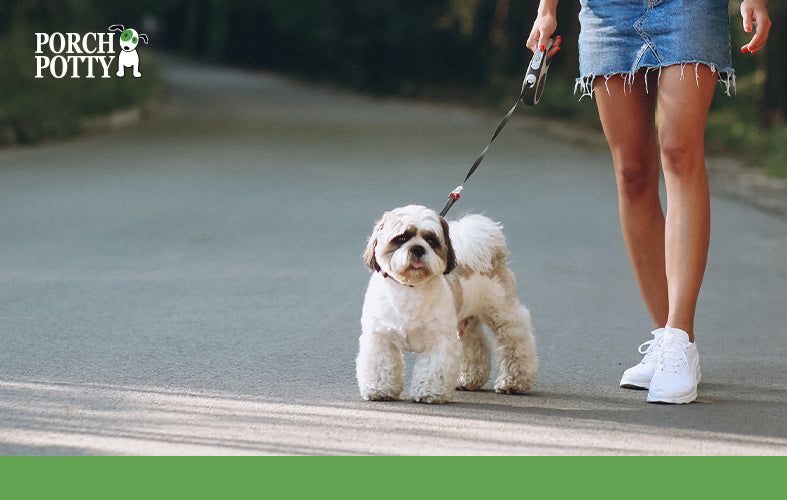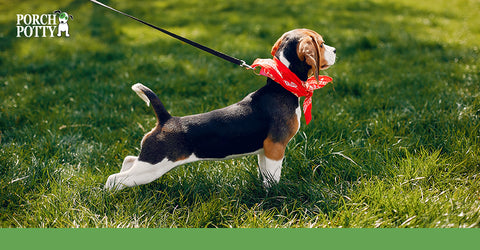
A woman wearing cut-off jean shorts and white tennis shoes stands beside a white shih tzu dog wearing a leash. They are walking on asphalt.
Getting a new puppy is a very exciting time! They are such a joy, but they come with a lot of responsibility as well. When caring for your puppy there are many things to consider, such as walking them! It may seem pretty straightforward, but there are a few things to consider before you venture outside with your beloved puppy.
The Importance Of Walking Your Puppy
Walking your puppy is key to them living a happy and long life. It is important for the physical and mental development of puppies. Taking your pup for daily walks will help them maintain a healthy weight and muscle mass, which is great for their overall health and mobility. Additionally, going for walks provides them with mental stimulation. Getting outside allows them to utilize their nose to sniff all of the interesting scents outside, which is like a brain exercise for them! Moreover, walks are a great way for puppy socialization as it exposes them to the sights and sounds of the world, as well as other dogs.

A vet wearing lavender scrubs and white medical gloves is holding a syringe with vaccinations mean for a small white dog in the background being held by a tech with light blue scrubs on.
Things to Consider Before Taking Your Puppy Outside
You may think that you can start going on outdoor adventures with your puppy immediately after getting them, but that is usually not the case! Before you start walking your puppy, you need to ensure that they are fully vaccinated. The reason for this is because the outdoors does come with health risks. These risks can be from other dogs or from wildlife. Some of the diseases that your pup can pick up may include parvovirus, distemper, adenovirus, leptospirosis, kennel cough, rabies, and more. This sounds pretty scary, as some of these conditions can be life threatening! To ensure that your pup is protected as much as possible, it is important to fully immunize them before venturing into unknown outdoor territory.
There are three sets of vaccinations for puppies that are typically given:
Set One: At 8 weeks of age
- Distemper
- Parvovirus
- Adenovirus
- Parainfluenza virus
Set Two: At 12 weeks of age (or 4 weeks after the first set of vaccines)
- Distemper
- Parvovirus
- Adenovirus
- Parainfluenza virus
- Bordetella (for kennel cough)
Set Three: At 16 weeks of age (or 4 weeks after the second set of vaccines)
- Distemper
- Parvovirus
- Adenovirus
- Parainfluenza virus
- Bordetella (for kennel cough)
- Rabies
- +/- Leptospirosis (with another booster at 20 weeks old, or 4 weeks after the first immunization for leptospirosis)
Once your puppy has received these vaccines, they will reach their peak immune response to the previously described diseases two weeks after their third set of vaccines. So for the average puppy, that is approximately 18 weeks old. While this does seem like a long time to wait to take your puppy on walks, it is well worth it to keep your puppy healthy.

A black, tan, and white beagle puppy wearing a red bandana collar and a black leash is standing and stretching its hind legs while outside on green grass.
Other Outdoor Activities for Puppies
Puppies are so full of energy so it is understandable that you want to get your puppy outside on walks as soon as possible (and to show them off to the neighborhood). Until your puppy is vaccinated, you can always let them outside in your fenced-in backyard or on puppy play dates. For the play dates, there are a few rules that must be followed though, since your puppy isn’t fully vaccinated. Only let your puppy interact with dogs that you know are fully vaccinated, and that you trust. That typically means letting them around family and friends’ dogs that you know would be kind to your puppy, and that you know don’t pose a health risk to your pup!
It is very important to socialize your puppy as soon as possible, so be sure to set up some play dates if possible!
Puppy Health and Safety On Walks
Once your pup is fully vaccinated and ready to venture into the great outdoors, there are a few things to consider to keep them safe!

A dark brown French bulldog is being given water from a plastic water bottle by a woman's hand.
Here are our walking tips:
- Always bring a water source (collapsible bowl and water bottle), even on cold days!
- On warm/hot days, walk them in the early morning and late evening to avoid the hottest points of the day.
- Be careful of hot pavement on summer days.
- On cold days, try to walk them at the warmest point of the day and/or dress them warm enough for the weather.
- Let your puppy dictate their own level of activity- if your pup starts slowing down on the walk, do not force them to continue as they need lots of rest! That being said, some breeds may try to over do it (like labs), so typically the rule of thumb is to walk them 5 minutes per each month of age, twice per day. So if your puppy is 5 months old, you can walk them for 25 minutes twice per day. If your puppy is tiring before then, shorten the walks!
- Always keep them on leash; even if they are friendly you never know how another dog may react.
- Avoid using flexi (retractable) leashes, as this can be a hazard for losing control of your pup, or allowing them to accidentally go onto the road.
- Bring treats- that way you can praise your dog throughout the walk, and distract them if need be.
- Allow your dog to sniff! As mentioned above, sniffing is a brain exercise for them and makes them happy!
- If you have a small puppy, consider using a harness instead of a collar as it won’t put pressure on their small neck to avoid predisposing them to a collapsing trachea.
- If you have a larger puppy, consider using a halti, or gentle leader to have better control over their strength. Collars are also okay but the halti and gentle leader tend to provide more control. Harnesses are not recommended for larger breeds (unless they are bulldogs) as that usually allows them to use their strength to pull you harder.
- Bring multiple dog poop bags. Sometimes puppies have to poop frequently!
Don’t forget to also have fun! Enjoy these special moments with your furry family member.
Jennifer Sawyer: Fourth Year Veterinary Student at Ontario Veterinary College. Jenny or @vetstudentjenny on Instagram, has been passionate about veterinary medicine and has worked in the industry for over a decade.
For more information about potty training and puppies, check out these articles:
What to Know About Dog Immunizations and Preventing Diseases
Vet Jenny: There’s More to Walking Your Dog Than Exercise
Training Tips: Leash Walking, Separation Anxiety, and Senior Dogs




